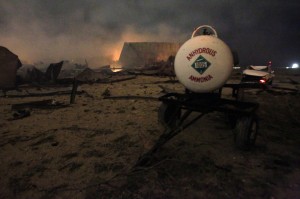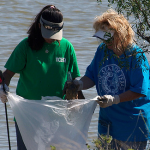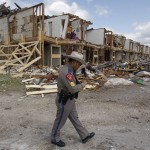Investigation: Disaster at West Fertilizer Plant Was ‘Preventable’

Photo by REUTERS /MIKE STONE /LANDOV
A chemical trailer sits among the remains of the burning fertilizer plant in April 2013.
Federal Agency Says ‘It Should Never Have Occurred’
A year after a deadly explosion at a fertilizer plant in Texas, a federal agency is releasing a report saying the disaster was preventable.
The Chemical Safety Board, which investigates chemical accidents and issues recommendations to ensure public safety, is presenting its preliminary findings tonight in the town of West, Texas, where the fire and subsequent explosion last year took 15 lives, injured hundreds, and destroyed homes and schools.
“It should never have occurred,” Dr. Rafael Moure-Eraso, the head of the agency, says in a statement. “It resulted from the failure of a company to take the necessary steps to avert a preventable fire and explosion and from the inability of federal, state and local regulatory agencies to identify a serious hazard and correct it.”
Texas’ lack of a statewide fire code — and state laws prohibiting many rural counties from adopting one — played a role, the agency says. “Local authorities and specifically—local fire departments—need fire codes so they can hold industrial operators accountable for safe storage and handling of chemicals,” Dr. Moure-Eraso says.
And the danger of West happening again isn’t limited to Texas, the agency says. It found 1,351 facilities across the U.S. storing ammonium nitrate, and communities are still learning about the proximity of those facilities to homes or schools. “Fertilizer industry officials have reported to the CSB that wooden buildings are still the norm for the distribution of ammonium nitrate across the U.S.,” the report says.
More regulation and data on ammonium nitrate storage should be accompanied by better training and coordination with local first responders, the agency says in the report. Best practices say that firefighters should move away from fires near large amounts of ammonium nitrate or flood them with water from a large distance; in West, first responders did the opposite. Most of those killed in the explosion were first responders.
“At the county level, McLennan County’s local emergency planning committee did not have an emergency response plan for West Fertilizer as it might have done under the federal Emergency Planning and Community Right to Know Act,” the report says. “The community clearly was not aware of the potential hazard at West Fertilizer.”
So what should be done at the local, state and federal level to prevent something like the West fertilizer plant explosion from happening again?
“Regulations need to be updated and new ones put in place,” agency head Moure-Eraso says in a statement. “The state of Texas, McLennan County, OSHA and the EPA have work to do, because this hazard exists in hundreds of locations across the U.S. However, it is important to note that there is no substitute for an efficient regulatory system that ensures that all companies are operating to the same high standards. We cannot depend on voluntary compliance.”

